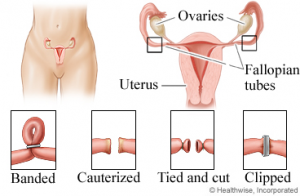#ThursdayThoughts
As promised, each Thursday, we will now offer you a piece of educational, science, or research related information. The purpose of our #ThursdayThoughts post is to share with you fact-based content that can enlighten and assist you on your fertility journey. Enjoy our post! Helping to Create New Beginnings….
Bilateral Tubal Ligation
Bilateral tubal ligation (BTL) is a surgical procedure that closes a woman’s fallopian tubes. During a natural pregnancy, an ovulated egg travels through the fallopian tube, is fertilized by sperm in the tube, and then travels to and implants in the uterus. A BTL is performed by cutting, cauterizing, or permanently blocking the fallopian tubes to prevent pregnancy. This procedure is effective; less than 1% of women get pregnant after tubal ligation and it does not affect hormones. However, it does not protect against sexually transmitted diseases and if a woman does become pregnant naturally after a BTL, she is at risk for ectopic pregnancy (pregnancy in the fallopian tube).
Although most women are happy with their decision to undergo BTL, some women with a history of BTL would like to know their options for expanding their families. Some women may choose to complete a tubal reversal if they are considering future pregnancy. In a study by Godin et al. pregnancy and term delivery rates for women between the ages of 27 to 39 after reversal were approximately 75 and 53%, respectively. However for women in their 40s, the rates were 68 and 27%. Several factors can influence future pregnancy after reversal. These include maternal age, type of tubal ligation procedure, length and function of tubes, scar tissue in the abdominal cavity, and partner’s semen analysis.
A successful tubal reversal depends on if there is enough healthy tissue once the tubes are reconnected. The type of sterilization technique and the length of remaining tube are important factors in a successful reversal (Jayakrishnan and Baheti, 2011). With any type of surgery, some scar tissue can develop which can disrupt the flow of the tube. A hysterosalpingogram (HSG) can be performed after surgery is completed to check the patency of these newly connected tubes. If both tubes are patent, women can try for pregnancy naturally with intercourse or with intrauterine insemination (IUI).
Another option for pregnancy after tubal ligation is in vitro fertilization, IVF. This process includes an egg being fertilized in a lab and then transferred into a women’s uterus. This procedure bypasses the fallopian tubes allowing pregnancy to occur.
If you have a history of BTL and would like to discuss options for expanding your family, please call the Fertility Institute of Hawaii at 808-545-2800 for an appointment with one of our physicians, or visit our website at https://www.ivfcenterhawaii.com/ for more information.
Godin PA, Syrios K, Rege G, Demir S, Charitidou E, Wery O. Laparoscopic Reversal of Tubal Sterilization; A Retrospective Study Over 135 Cases. Front Surg. 2019;5:79. Published 2019 Jan 9. doi:10.3389/fsurg.2018.00079
Jayakrishnan K, Baheti SN. Laparoscopic tubal sterilization reversal and fertility outcomes. J Hum Reprod Sci. 2011;4(3):125-129. doi:10.4103/0974-1208.92286
